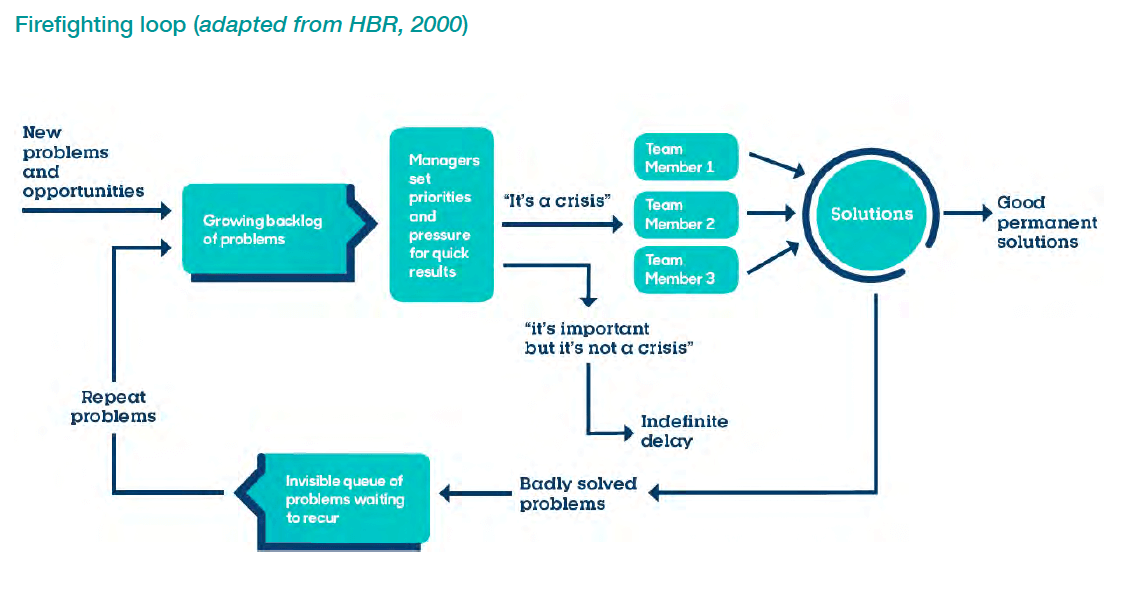Posted in Blog, Create, Lead by Jo North
Why Whac-a-Mole Management Prevents Innovation, and What To Do About It
As a teenager in the 1980s, I spent a lot of time playing Whac-A-Mole in the arcades of Skegness, the seaside holiday town where I grew up.
You may have seen or heard about the classic arcade game Whac-A-Mole, too. If not, have a look at the video here.
The point of the game? Strike down plastic moles with a rubber mallet as they pop up.
Whac-a-mole Management in Business
What’s fun in a game of whack becomes counterproductive in the business context. Much like managing our never-ending to-do list or juggling incessant Teams or Zoom calls, we often find ourselves in a mole situation, attempting to address emergent events without tackling their root causes. Just as one project finishes or one crisis is managed, the next mole pops up demanding a sense of urgency.
A Downward Spiral of Ineffectiveness
This “Whac-A-Mole management” method leads to a downward spiral of ineffectiveness.
Company leaders, including project managers, need to steer clear of this mole process if they want to achieve successful business innovation.
Being perpetually “busy” is different from doing the right things. A project manager might tick off tasks from their list, but are they the most important thing on that list? It’s crucial to prioritize.
Taking cues from life’s experiences, the best solution lies in leveraging new tools and strategies that evolve from project management. How many board members have sat in meetings discussing new initiatives, only to be sidetracked by impossible things that suddenly become urgent? Such distractions pull focus away from strategic thinking, essential for innovation.
Not Everyone in the Business Needs to Chase the Ball
Think of the team sports analogy. Just as in sports, where every player doesn’t chase the ball but rather plays a strategic role, in business, not every team member should chase the newest or loudest issue. Teams need to learn how to discern the difference between genuine crises and distractions. To do this, it’s important to analyze the mole’s root causes. Ensure that issues are addressed at their source, rather than superficially.
Whac-a-Mole Management is Reactive Leadership
Whac-A-Mole is a great metaphor for reactive leadership. We give high energy and focus to whatever priority pops up there and then, but another priority, problem or even crisis pops up somewhere else when we aren’t looking. Sometimes great opportunities slip past us because we simply haven’t noticed them, or don’t have the physical or mental bandwidth to pursue them.
The unexpected happens to us all. There are times when we really do need to drop almost everything and get something sorted. It’s part of life.
Whac-a-Mole Management is a Habit
What I see all too often in business, though, is that Whac-A-Mole management has become a habit. It’s an engrained part of the culture.
The challenge is that it can feel really good. Some people who enjoy reactive management can find it exciting and rewarding, and once we have whacked some moles successfully, we temporarily feel like superheroes! Businesses often reinforce this by rewarding such superhero-ness, even it’s just through admiration and thanks.

Don’t Confuse Productivity with Whac-A-Mole Management
Whac-A-Mole management might also help some of us feel like we are being busy and productive. We can get pleasure from being busy. By being busy, I mean being on a constant treadmill of activity from one end of the day to the other, always on the phone and email, taking action and making decisions without stopping to think about what all the activity is for, and how effectively it is assisting us in reaching our most important goals.
We might like being busy for its own sake, or because we find sitting still is boring. It can bring a range of rewards, depending on the individual. For example, if we are very busy, it means that:
- Our jobs (and therefore, we) must be very important.
- We are doing a great job because we are showing how committed we are.
- We don’t have time to do those things we don’t want to do, even if we say we want to do them and think that we really do!
- Others will marvel at just how well we manage our busy-ness.
Some of these may not apply directly to you, but they might be relevant to the people you work with.
Being Busy is Not the Same as Being Efficient and Effective
The problem with busy-ness is that it does not allow us to access the full potential of our brainpower. It’s like driving without changing gear, even when another gear is more appropriate, comfortable and efficient. Busy-ness gets in the way of reflections from big, strategic thinking to smaller, mini-genius style insights that can make a difference to you, your team or business.
The Firefighting Loop
Some people (and organisations) consequently get stuck in a firefighting loop, like the one shown here, which I have adapted from an article in the Harvard Business Review:

When I share my version of the firefighting loop with executive coaching clients and workshop delegates, the principles always resonate. Here’s a walk-through of the process it describes:
- New problems and opportunities are constantly presenting themselves, creating a growing backlog of problems and challenges.
- Managers are under pressure to perform. They set priorities and may focus on achieving quick results.
- Where a new problem is urgent, or a crisis, it becomes a priority. It gets solved. Sometimes a permanent solution that prevents the same thing happening again is found through proper investigation, exploration and effort. Alternatively, a makeshift or only partially considered solution is developed, meaning that the problem joins a queue of other problems that are likely to recur because they’ve not been fully addressed.
- The repeat problems then join the new problems and opportunities that are constantly streaming into the beginning of the loop, and the process is repeated.
The Problem with Firefighting
I must admit that I secretly enjoy a bit of mole-whacking from time-to-time myself. It can feel good once the challenge has passed. And there’s a huge BUT:
- Working like this can become a habit. For those who enjoy it, it’s quite addictive.
- When overdone it’s exhausting, even if we don’t realize it at the time. It becomes our new normal, and it’s easy to forget that there is another way.
- Too much mole-whacking will stunt personal and business growth, as the balance between day-to-day delivery and taking longer-term development action is ‘off’.
- It really does reduce creativity and innovation. Granted, to whack some of the moles, you need some creativity. But it’s not the sort of deep creativity that could have prevented the problem or issue in the first place.
It all reminds me of the opening paragraph of A. A. Milne’s Winnie-the-Pooh:
“Here is Edward Bear coming downstairs now, bump, bump, bump, on the back of his head, behind Christopher Robin. It is, as far as he knows, the only way of coming downstairs, but sometimes he feels that there really is another way… if only he could stop bumping for a moment and think of it!”

Be a Real Business Superhero
The real superheroes in business are those who see that a mole could pop up, and have the foresight and creativity to take action in good time to stop it happening.
They also put in place preventative strategies to reduce risk, as well as create and optimize opportunities. This feels very different from mole-whacking. The shift is more mentally and personally challenging than practically so.
Some of my coaching clients who have moved from operational to strategic roles as part of their career progression say they really notice a difference. They almost feel guilty because they feel like they are doing less, even though they are not. The work they are doing is just a different kind.
Focus on What You Can Control and Influence
I appreciate that this may be extra-challenging if you work in a wider culture that is teeming with mole-whacking activity and expectations. My advice for you is to focus on what you can control and influence within how you organise yourself and the work that you are responsible for.
How to Break Your Whac-a-Mole Management Cycle
Here are some simple and effective steps that you can take to break your reactive leadership cycle. Each of these steps is supported by experience-based evidence:
- Self-awareness is key. Once you’ve recognised that you’re doing Whac-A-Mole management, you can change it if you choose, but you’ve got to spot it and then acknowledge it first.
- If you are doing a lot of mole-whacking, instead of trying to change this all at once, focus on your next new big project or goal, and resolve to take a different, more pre-emptive, structured and creative approach to it. Then do the same with your next project, the one after that and so on. Over time you will gradually shift from a reactive to a proactive leadership approach.
- This one is an oldie but a goodie! Be ruthless about creating some time each week – even if it’s half an hour, for the important and non-urgent things you want to achieve. My definition of ‘important things’ are those tasks or initiatives that you don’t need complete right away, often take a long period of time to do, and will add significant value or give real benefits. Examples include many learning and development activities, working to improve systems and processes, R&D, ongoing stakeholder engagement.
Benefits of Becoming Less Reactive
The benefits of becoming less reactive in your approach will pay big dividends when it comes to your creative thinking and innovation projects.
You’ll also become more in the habit of finding permanent solutions to many of your recurring challenges. This encourages deeper creative problem-solving capability. Our brains have the fabulous feature of plasticity. The more we practise our creative thinking skills, the better, more natural and more efficient creative thinkers we become.
And of course, by not spending so much time dealing with recurring issues, you will benefit from the opportunity of freeing your mind to develop creative ideas and plans that will take your business forward.
I hope you join me on my quest to minimize Whac-A-Mole management and to release more time and space for creativity and innovation! I’d love to hear about the challenges you have with this, and any strategies you use to reduce reactive management. Do get in touch with me here.


